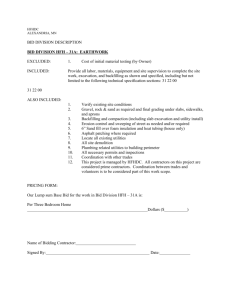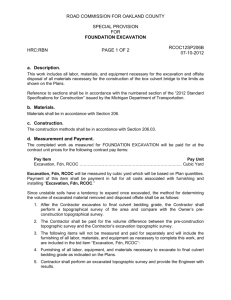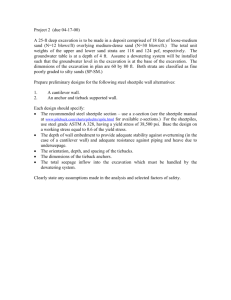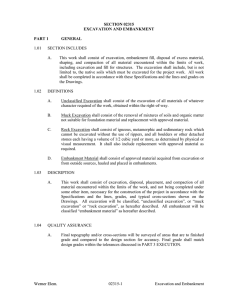1.01 SECTION INCLUDES A.
advertisement
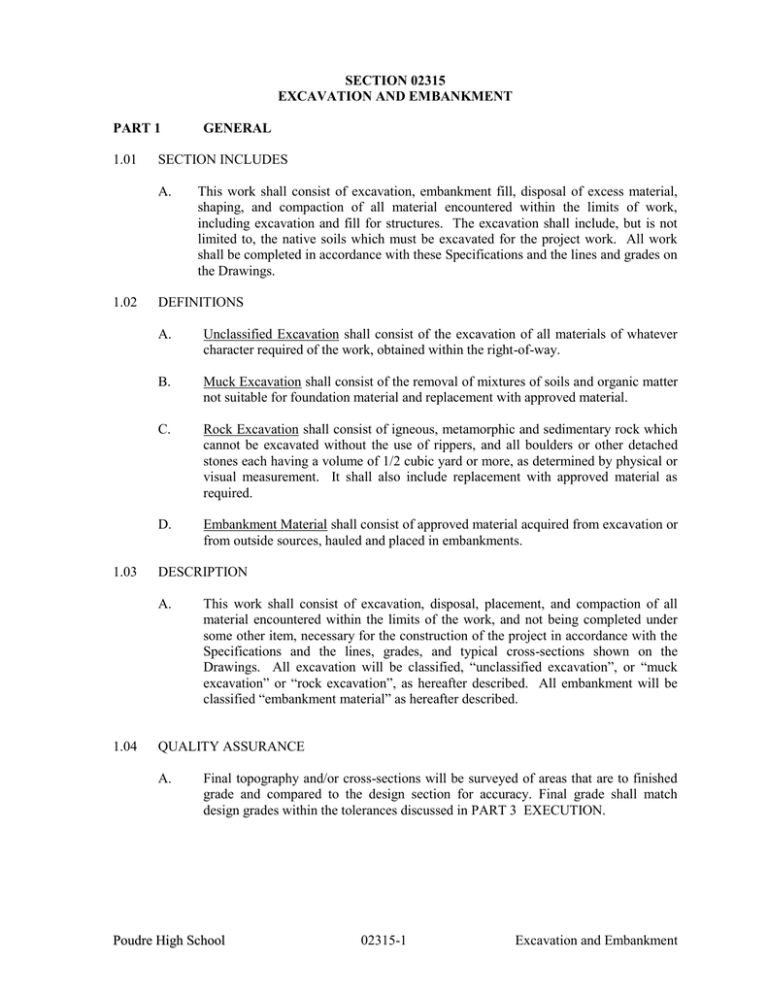
SECTION 02315 EXCAVATION AND EMBANKMENT PART 1 1.01 SECTION INCLUDES A. 1.02 1.03 This work shall consist of excavation, embankment fill, disposal of excess material, shaping, and compaction of all material encountered within the limits of work, including excavation and fill for structures. The excavation shall include, but is not limited to, the native soils which must be excavated for the project work. All work shall be completed in accordance with these Specifications and the lines and grades on the Drawings. DEFINITIONS A. Unclassified Excavation shall consist of the excavation of all materials of whatever character required of the work, obtained within the right-of-way. B. Muck Excavation shall consist of the removal of mixtures of soils and organic matter not suitable for foundation material and replacement with approved material. C. Rock Excavation shall consist of igneous, metamorphic and sedimentary rock which cannot be excavated without the use of rippers, and all boulders or other detached stones each having a volume of 1/2 cubic yard or more, as determined by physical or visual measurement. It shall also include replacement with approved material as required. D. Embankment Material shall consist of approved material acquired from excavation or from outside sources, hauled and placed in embankments. DESCRIPTION A. 1.04 GENERAL This work shall consist of excavation, disposal, placement, and compaction of all material encountered within the limits of the work, and not being completed under some other item, necessary for the construction of the project in accordance with the Specifications and the lines, grades, and typical cross-sections shown on the Drawings. All excavation will be classified, “unclassified excavation”, or “muck excavation” or “rock excavation”, as hereafter described. All embankment will be classified “embankment material” as hereafter described. QUALITY ASSURANCE A. Final topography and/or cross-sections will be surveyed of areas that are to finished grade and compared to the design section for accuracy. Final grade shall match design grades within the tolerances discussed in PART 3 EXECUTION. Poudre High School 02315-1 Excavation and Embankment PART 2 2.01 MATERIALS A. Embankment material may consist of approved material acquired from excavations or material hauled from outside the project limits. Suitable material identified on-site shall be used first for embankments and backfill. Excess excavated native soils which are not used as embankment or backfill shall become the property of the CONTRACTOR and shall be disposed of off-site by the CONTRACTOR, in a location acceptable to the ENGINEER OWNER. B. Muck excavation shall also include the replacement of excavated muck with uniformly graded rock, riprap, on-site or imported soils, or other material whichever is most suitable for the specific situation encountered. The ENGINEER OWNER will determine which type of aggregate or other material which shall be used after observing the specific site conditions. PART 3 3.01 PRODUCTS EXECUTION GENERAL EXCAVATION/EMBANKMENT A. General: The excavation and embankment for the project work should be finished to reasonably smooth and uniform surfaces. Variation from the subgrade plane shall not be more than .08 feet in soil or more than .08 feet above or .50 below in rock. Where bituminous or concrete surfacing materials are to be placed directly on the subgrade, the subgrade plane shall not vary more than 0.04 feet. Materials shall not be wasted without permission of the ENGINEER OWNER. Excavation operations shall be conducted so that material outside of the limits of slopes will not be disturbed. Prior to beginning grading operations in any area, all necessary clearing and grubbing in that area shall have been performed in accordance with Section 02230 of these Specifications. The CONTRACTOR shall notify the ENGINEER OWNER in sufficient time before beginning excavation or embankment such that the necessary topography and/or cross-sections may be taken. The CONTRACTOR shall not excavate beyond the dimensions and elevations established, and material shall not be removed prior to surveying the site. When the CONTRACTOR’s excavating operations encounter remains of pre-historic people’s dwelling sites or artifacts of historical or archaeological significance, the operations, shall be temporarily discontinued. The ENGINEER OWNER will contact archaeological authorities to determine the disposition thereof. When directed, the CONTRACTOR shall excavate the site in such a manner as to preserve the artifacts encountered and shall remove them for delivery to the custody of the proper state authorities. Such excavation will be considered and paid for as extra work. Poudre High School 02315-2 Excavation and Embankment B. Excavation: 1. Unclassified: All excess suitable material excavated from the project site and not used for embankment shall be removed from the project site and become the property of the CONTRACTOR. Where material encountered within the limit of the work is considered unsuitable for embankment (fills) on any portion of this project work, such material shall be excavated as directed by the ENGINEER OWNER and replaced with suitable fill material. All unsuitable excavated material from excavation consisting of any type of debris (surface or buried), excavated rock, bedrock or rocks larger than 6 inches in diameter and boulders shall be hauled from the project site and disposed of by the CONTRACTOR at his expense. Debris is defined as “anything that is not earth which exists at the job site”. 2. Muck: Where excavation to the finished grade section results in a subgrade or slopes of unsuitable soil, the ENGINEER OWNER may require the CONTRACTOR to remove the unsuitable materials and backfill to the finished graded section with approved material. Disposal of the material shall be at the CONTRACTOR’s expense. Good surface drainage shall be provided around all permanent cuts to direct surface runoff away from the cut face. 3. C. Rock: Unless otherwise specified, rock shall be excavated to a minimum depth of 0.5 feet below subgrade within the limits of the channel area, and the excavation shall be backfilled with material shown on the Drawings or as designated by the ENGINEER OWNER. Disposal of material and replacement with suitable approved material shall be at the CONTRACTOR’s expense. Embankment Construction: Embankment construction shall consist of constructing all fill areas, including preparation of the areas upon which they are to be placed, the placing and compacting of approved material within areas where unsuitable materials have been removed, the preparation of subgrade for pavement, and the placing and compacting of embankment material in holes, pits and other depressions within the project area. Only approved materials shall be used in the construction of embankments and backfills. Approved materials shall consist of clean on-site cohesive soils or approved imported soils. On-site materials should not be used without the approval of the ENGINEER OWNER if select material is called for in the Drawings. On-site cohesive soils are suitable for use as compacted fill provided the following recommendations are met: Percent Finer by Weight (ASTM C136) Gradation ½-Inch 3/8-Inch No. 4 Sieve No. 200 Sieve Poudre High School 02315-3 100 70 – 100 50 – 100 60 (min) Excavation and Embankment Liquid Limit Plasticity Index In-Situ Coefficient of Permeability 35 (max) 20 (max) 1x10-6 cm/sec (min) On-site cohesive soils or imported soils should be placed and compacted in horizontal lifts, using equipment and procedures that will produce recommended moisture contents and densities throughout the lift and embankment height. On-site or imported cohesive soils should be compacted within a moisture content range of 2% below, to 2% above optimum moisture content and compacted to 95% of the Maximum Standard Proctor Density (ASTM D698). When embankment is to be placed and compacted on hillsides, or when new embankment is to be compacted against existing embankments, or when embankment is built 1/2 width at a time, the slopes that are steeper than 4:1 when measured longitudinally or at right angles to the adjacent ground shall be continuously benched over those areas where it is required as the work is brought up in layers. Benching shall be well keyed and where practical a minimum of 8 feet. Each horizontal cut shall begin at the intersection of the original ground and the vertical sides of the previous cuts. Material thus cut out shall be recompacted along with the new embankment material at the CONTRACTOR’s expense. The ground surface underlying all fills shall be carefully prepared by removing all organic matter, scarification to a depth of 8 inches and recompacting to 95% of the Maximum Standard Proctor Density (ASTM D698) at optimum moisture content + or - 2% prior to fill placement. Embankment material shall be placed in horizontal layers not exceeding 8 inches (loose measurement) and shall be compacted to 95% of the Maximum Standard Proctor Density (ASTM D698) at optimum moisture content + or - 2%. Effective spreading equipment shall be used on each lift to obtain uniform thickness prior to compacting. As the compaction of each layer progresses, continuous leveling and manipulating will be required to assure uniform density. For embankments which serve as berms, the downstream portion shall be “keyed” into the subsurface soils a minimum of 3 feet to enhance the stability of the slope. Materials which are removed from excavations beneath the water table may be over the optimum moisture content and will require that they be dried out prior to reusing them. Cross hauling or other action as appropriate will be ordered when necessary to insure that the best available material is placed in critical areas of embankments, including the top 2 feet of all embankments. No additional payment will be made for cross hauling ordered by the ENGINEER OWNER. Frozen materials shall not be used in construction of embankments. During the construction of the channels, the channel bottom shall be maintained in such condition that it will be well drained at all times. Excavation or Embankment (Fill), and Structural Backfill work either completed or in a stage of completion that is either eroded or washed away or becomes unstable Poudre High School 02315-4 Excavation and Embankment due to either rains, snow, snow melt, channel flows or lack of proper water control shall be either removed and replaced, recompacted or reshaped as directed by the ENGINEER OWNER and in accordance with the Drawings and Specifications at the CONTRACTOR’s sole expense. Removed unsuitable materials shall be hauled away and disposed of at the CONTRACTOR’s expense. Placing of replacement materials for removed unsuitable materials shall be purchased, placed and compacted at the CONTRACTOR’s expense. D. Proof rolling with a heavy rubber tired roller will be required, if designated on the Drawings or when ordered by the ENGINEER OWNER. Proof rolling shall be done after specified compaction has been obtained. Areas found to be weak and those areas which failed shall be ripped, scarified, wetted if necessary, and recompacted to the requirements for density and moisture at the CONTRACTOR’s expense. Proof rolling shall be done with equipment and in a manner acceptable to the ENGINEER OWNER. Proof rolling as shown on the Drawings or as ordered by the ENGINEER OWNER shall not be measured and paid for separately, but shall be included in the unit prices bid for the work. 3.02 EXCAVATION AND BACKFILL FOR STRUCTURES A. Poor foundation material for any of the work shall be removed, by the CONTRACTOR, as directed by the ENGINEER OWNER. The CONTRACTOR will be compensated for removal and replacement of such materials in accordance with Muck Excavation. The CONTRACTOR is cautioned that construction equipment may cause the natural soils to pump or deform while performing excavation work inside and on footings, structural floor slabs, or other structure foundation areas. Foundation materials which are: a) saturated by either surface or subsurface flows due to the lack of adequate water control or dewatering work by the CONTRACTOR; b) frozen for any reason; or, c) that are disturbed by the CONTRACTOR’s work or caused to become unacceptable for foundation material purposes by means of the CONTRACTOR’s equipment, manpower, or methods of work shall be removed and replaced by the CONTRACTOR at his expense. Dewatering should not be conducted by pumping from inside footing, structural floor slab, or other structure foundation limits. This may decrease the supporting capacity of the soils. Care should be taken when excavating the foundations to avoid disturbing the supporting materials. Excavation by either hand or careful backhoe soil removal, may be required in excavating the last few inches of material to obtain the subgrade of any item of the concrete work. Any over-excavated subgrades that are due to the CONTRACTOR’s actions, shall be brought back to subgrade elevations by the CONTRACTOR and at his expense in the following manner: 1. Poudre High School For over-excavations of 2 inches or less, either: Backfill and compact with an approved granular materials; backfill with 1/2 inch crushed rock; or fill within concrete at the time of the appurtenant structure concrete pour. 02315-5 Excavation and Embankment 2. For over-excavations greater than 2 inches, backfill and compact with an approved granular material. All granular footings, structural floor slabs, or other structure areas shall be compacted with a vibratory plate compactor prior to placement of concrete, reinforcing, or bedding materials. Backfill, and fill within 3 feet of, or adjacent to, all structures and for full height of the walls, shall be selected non-swelling material. It shall be granular, well graded, and free from stones larger than 2 inches. Material may be job excavated, but selectivity will be required as determined by the ENGINEER OWNER. Stockpiled material, other than topsoil from the excavation shall be used for backfilling unless an impervious structural backfill is specified. The backfill material shall consist of either clean on-site granular materials free of stones larger than 2 inches in diameter with no more than 20% passing the No. 200 sieve, or equivalent imported materials. All backfill around the structures shall be consolidated by mechanical tamping. The material shall be placed in 6-inch loose lifts within a range of 2% above to 2% below the optimum moisture content and compacted to 95% of Maximum Standard Proctor Density (ASTM D698) for cohesive soils, or to 75% relative density for pervious material as determined by the relative density of cohesionless soils test, ASTM D4253. When specified on the Drawings or as required by the ENGINEER OWNER, Class I structural backfill shall meet the following gradation requirements: % by Weight Passing Square Mesh Sieves Sieve Size 2-Inch No. 4 No. 50 No. 200 100 30 - 100 10 – 60 5 – 20 In addition, this material shall have a liquid limit not exceeding 35 and a plasticity index of not over 6. Impervious structural backfill, where shown or specified, shall consist of material having 100% finer than 2 inches in diameter and a minimum of 30% passing a No. 200 U.S. Standard Sieve. The material shall be placed in 6-inch loose lifts within a range of 2% above to 2% below the optimum moisture content and compacted to 95% of Maximum Standard Proctor Density for cohesive soils as determined by ASTM D698. END OF SECTION Poudre High School 02315-6 Excavation and Embankment


